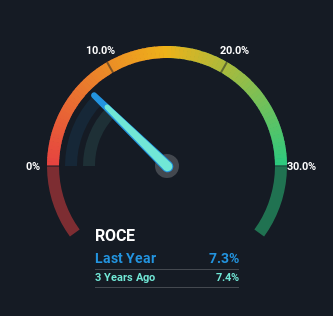What trends should we look for it we want to identify stocks that can multiply in value over the long term? One common approach is to try and find a company with returns on capital employed (ROCE) that are increasing, in conjunction with a growing amount of capital employed. This shows us that it's a compounding machine, able to continually reinvest its earnings back into the business and generate higher returns. Although, when we looked at Toyota Motor (TSE:7203), it didn't seem to tick all of these boxes.
We've discovered 3 warning signs about Toyota Motor. View them for free.What Is Return On Capital Employed (ROCE)?
For those who don't know, ROCE is a measure of a company's yearly pre-tax profit (its return), relative to the capital employed in the business. Analysts use this formula to calculate it for Toyota Motor:
Return on Capital Employed = Earnings Before Interest and Tax (EBIT) ÷ (Total Assets - Current Liabilities)
0.073 = JP¥4.8t ÷ (JP¥95t - JP¥29t) (Based on the trailing twelve months to December 2024).
Thus, Toyota Motor has an ROCE of 7.3%. In absolute terms, that's a low return but it's around the Auto industry average of 9.1%.
View our latest analysis for Toyota Motor

In the above chart we have measured Toyota Motor's prior ROCE against its prior performance, but the future is arguably more important. If you're interested, you can view the analysts predictions in our free analyst report for Toyota Motor .
What The Trend Of ROCE Can Tell Us
There are better returns on capital out there than what we're seeing at Toyota Motor. Over the past five years, ROCE has remained relatively flat at around 7.3% and the business has deployed 83% more capital into its operations. Given the company has increased the amount of capital employed, it appears the investments that have been made simply don't provide a high return on capital.
The Bottom Line On Toyota Motor's ROCE
In conclusion, Toyota Motor has been investing more capital into the business, but returns on that capital haven't increased. Yet to long term shareholders the stock has gifted them an incredible 120% return in the last five years, so the market appears to be rosy about its future. Ultimately, if the underlying trends persist, we wouldn't hold our breath on it being a multi-bagger going forward.
Toyota Motor does come with some risks though, we found 3 warning signs in our investment analysis, and 2 of those can't be ignored...
While Toyota Motor may not currently earn the highest returns, we've compiled a list of companies that currently earn more than 25% return on equity. Check out this free list here.
Valuation is complex, but we're here to simplify it.
Discover if Toyota Motor might be undervalued or overvalued with our detailed analysis, featuring fair value estimates, potential risks, dividends, insider trades, and its financial condition.
Access Free AnalysisHave feedback on this article? Concerned about the content? Get in touch with us directly. Alternatively, email editorial-team (at) simplywallst.com.
This article by Simply Wall St is general in nature. We provide commentary based on historical data and analyst forecasts only using an unbiased methodology and our articles are not intended to be financial advice. It does not constitute a recommendation to buy or sell any stock, and does not take account of your objectives, or your financial situation. We aim to bring you long-term focused analysis driven by fundamental data. Note that our analysis may not factor in the latest price-sensitive company announcements or qualitative material. Simply Wall St has no position in any stocks mentioned.
About TSE:7203
Toyota Motor
Designs, manufactures, assembles, and sells passenger vehicles, minivans and commercial vehicles, and related parts and accessories in Japan, North America, Europe, Asia, Central and South America, Oceania, Africa, and the Middle East.
Adequate balance sheet average dividend payer.
Similar Companies
Market Insights
Community Narratives



